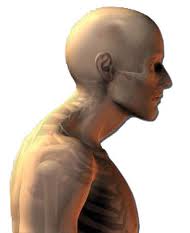
Forward head posture is a condition that occurs when your head and neck are too far in front of your body. This condition occurs as a result of tight and/or weak muscles, and poor postural habits. In addition to looking bad, forward head posture can lead to painful muscles, headaches, and even pinched nerves. However, it is possible to improve your posture over time by being mindful of the position of your head, as well as utilizing several simple exercises to strengthen your muscles and keep you in proper alignment.
The Malady:
Forward Head Posture (FHP)
The Facts:
Forward head posture occurs when the cranium, which rests on the cervical (neck) vertebrae, becomes positioned too far in front of the rest of the body. The result is a stooped posture that creates tightness and pain in the neck muscles. If left uncorrected, the head will go further and further forward and the back will start to hunch as a result. These changes only occur over a prolonged period of time, so if they are identified, they are easy to correct with several postural adjustments.
The Symptoms:
One simple way to tell if you have FHP is by standing in your normal stance, and having a friend take a picture of you from the side. A person with FHP will have their ears anterior (forward) of the shoulder seam of their t-shirt. The chin will be pointed forward instead of down. As a result, the person may experience tightness in the neck, and soreness and tenderness in the upper back muscles. Some patients complain of radiating pain as well; if you experience pain, tingling or numbness in the face or arms, contact your medical professional immediately, as this can be a sign of a pinched nerve.
What is Happening:
In FHP, as the chin and head slowly shift forward, the muscles in the back of the neck become very tight and painful. This tight feeling can cause anything from mild discomfort, to unbearable pain in the neck, head, and even down the arms. Over time the muscles tighten in whatever position you keep them in, so prolonged periods of FHP make it difficult to move your head back into position. As the muscles tighten, the vertebrae of your neck can also get stiff, thereby causing difficulty in moving your neck properly.
Why Is This Happening:
FHP occurs due to the effect of gravity on the body. As the head slowly tilts forward, gravity begins to push it down into the chest, instead of down into the vertebrae upon which it rests. This in turn causes your head to bow down towards your chest, which pushes your face down. However, your brain automatically centers your eyes ahead of you, so it cranes your head up. Your neck muscles are then supporting your head all day against the force of gravity instead of your head resting on its bony supports. As a result, your head rests in a FHP, and your neck muscles become exhausted from holding your head up all day.
Lifestyle Adjustments:
The biggest change you can make with this condition, like many others, is correcting the positions that got you here in the first place. Always be conscious of the following posture guidelines:
1) Pull your shoulder blades back when you sit or stand
2) Keep your back straight and your belly button pulled in
3) Set alarms on your phone to remind you to exercise good posture, or have friends or loved ones remind you
Wearing warm clothing in the winter is another helpful tip, as cold weather makes you shrug your shoulders into your ears, thereby tightening your neck muscles. Finally, many of you carry your stress in your necks, which causes those muscles to chronically spasm. Remember to leave time every day to meditate or release the stress from your day.
Prevent It
Prevention of forward head posture revolves around postural awareness. Make sure to keep your head upright and looking straight ahead, and keep your neck straight without bending forward. Avoid craning your head forward to read small print. This is especially true in today’s “smart phone” days; it is critical that you bring the phone towards your face, and not the other way around!
Fix It
In order to fix forward head posture, you must stretch the tight muscles and strengthen the weak ones. The muscles that become the tightest are the upper traps and suboccipitals, which are at the back of your neck running along your spine. Chin tucks and upper trap stretches act to loosen up your muscles. The scapular retractions act to push your shoulder blades back and open your chest, which will allow your neck to align into proper position easier.
